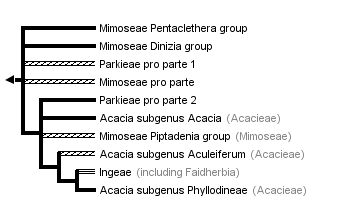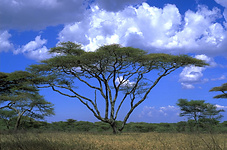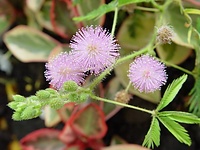Mimosoideae
Martin F. Wojciechowski


This tree diagram shows the relationships between several groups of organisms.
The root of the current tree connects the organisms featured in this tree to their containing group and the rest of the Tree of Life. The basal branching point in the tree represents the ancestor of the other groups in the tree. This ancestor diversified over time into several descendent subgroups, which are represented as internal nodes and terminal taxa to the right.

You can click on the root to travel down the Tree of Life all the way to the root of all Life, and you can click on the names of descendent subgroups to travel up the Tree of Life all the way to individual species.
For more information on ToL tree formatting, please see Interpreting the Tree or Classification. To learn more about phylogenetic trees, please visit our Phylogenetic Biology pages.
close boxIntroduction
"Mimosoids" form one of the major groups of legumes and have been usually recognized as the subfamily Mimosoideae within the family Fabaceae. The group consists of about 80 genera (c. 3,270 spp.) of trees, shrubs, and lianas found mainly in tropical, subtropical, and warm temperate regions of the world where they serve as important sources of forage and fuel (Luckow et al., 2003). Tropical America, Africa and Australasia are centers of greatest diversity for mimosoids. Members of this subfamily are common in lowland tropical rainforests, especially along rivers and near lakes, but have also successfully adapted to drier savannas, scrub and thorn forests, and arid desert regions in the Americas and Africa (Elias, 1981).
Characteristics
As mentioned elsewhere, the aestivation of petals and sepals [see aestivation patterns] (pattern of arrangement of these organs in the developing flower) have been of fundamental importance in distinguishing the three subfamilies within Fabaceae (Polhill and Raven, 1981), with the Mimosoideae characterized as having valvate (non-overlapping), rather than imbricate (as in the Caesalpinioideae and Papilionoideae), aestivation of the petals and typically the sepals (Luckow et al., 2003). Most mimosoids have small (< 1-2 cm), regular or actinomorphic (radially symmetrical) flowers aggregated into spicate or capitate heads, with stamens usually 3 to 10 but sometimes many (>100). The filaments of the stamens are often long and brightly colored (orange to red), making for attractive inflorescences. Root nodules are generally present suggesting most if not all mimosoids exhibit symbiotic nitrogen fixation (Sprent, 2001). Leaves in this subfamily are mostly bipinnate (i.e., twice pinnately compound) and often have specialized glands. In many of the endemic Australian species of Acacia the leaves are reduced to simple "phyllodes".
Discussion of Phylogenetic Relationships
The classification of Mimosoideae has until recently followed closely that of Bentham (1875), who recognized five tribes based partly on aestivation of the sepals but also on androecial characters (male reproductive parts, stamens). However, recent phylogenetic studies based on molecular sequence and morphological data have cast serious doubt on the monophyly of these tribes in Mimosoideae (Luckow et al., 2000, 2003). Previously separated into twelve informal generic groups (Lewis & Elias, 1981; Polhill, 1994) based largely on morphological and chemical data, Luckow et al. (2003) and Miller et al. (2003) have used analyses of DNA sequences to begin to resolve relationships among these groups within the subfamily. Results from their work and other studies (e.g., Wojciechowski et al., 2004) have suggested members of the Dinizia and/or Pentaclethra groups comprise the basally branching lineages within mimosoids with tribes Acacieae and Ingeae nested within a paraphyletic Mimoseae. Neither Acacieae nor Ingeae are presently resolved as monophyletic groups, but sampling of taxa from these, as all the tribes, is still not extensive. The placement of Faidherbia (formerly Acacieae) in Ingeae (Polhill, 1994; Luckow et al., 2003) renders Acacieae monogeneric, with the single genus Acacia. Recent work by Luckow et al. (submitted) indicates that Mimozyganthus (formerly treated as monotypic tribe Mimozyganthese) is also nested within the paraphyletic tribe Mimoseae.
The taxonomic status of the predominantly southern hemisphere genus Acacia ("acacias", "wattles"), containing more than 1450 species, has long been controversial, and recent morphological and molecular phylogenetic studies have shown that the genus as currently circumscribed is polyphyletic and will ultimately need to be divided into four to five genera. Pedley (1986) recommended the three presently recognized subgenera, Acacia, Aculeiferum, and Phyllodineae, be segregated as Acacia sens. str., Senegalia Raf., and Racosperma Mart., respectively, but other authors, such as Maslin (1988) and Vassal (1988), did not adopt Pedley's segregates although they agreed that Acacia was polyphyletic. The proposal (number 1584 by Orchard & Maslin, 2003) to retypify Acacia according to rules governing the International Code of Botanical Nomenclature, based on the type of the Australian taxon Acacia penninervis Sieber ex. DC., and recommended by the Committee for Spermatophyta, was controversial within the legume systematics community (Luckow et al., 2005). The proposal was recently adopted at the XVII International Botanical Congress in Vienna, Austria, in July 2005. This decision, effectively conserving the name Acacia so that it applies to the Australian species, will require a substantial number of changes to generic and infrageneric names in Acacia (e.g. Luckow et al., 2005).
References
Bentham, G. 1875. Revision of the suborder Mimoseae. Transactions of the Linnean Society, London 30: 335-664.
Elias, T. S. 1981. Mimosoideae. Pages 143-151 in Advances in legume systematics, part 1 (R. M. Polhill and P. H. Raven, eds.). Royal Botanic Gardens, Kew, UK.
Lewis, G. P., and T. S. Elias. Mimoseae. Pages 155-168 in Advances in Legume Systematics, part 1 (R.M. Polhill and P.H. Raven, eds.). Royal Botanic Gardens, Kew, UK.
Lewis, G., Schrire, B., Mackinder, B., & Lock, M. (eds). 2005. Legumes of the World. Royal Botanic Gardens, Kew.
Luckow, M., P. J. White, and A. Bruneau. 2000. Relationships among the basal genera of mimosoid legumes. Pages 165-180 in Advances in Legumes Systematics, part 9, (P. S. Herendeen and A. Bruneau, eds.). Royal Botanic Gardens, Kew, UK.
Luckow, M., J. T. Miller, D. J. Murphy, and T. Livshultz. 2003. A phylogenetic analysis of the Mimosoideae (Leguminosae) based on chloroplast DNA sequence data. Pages 197-220 in Advances in Legumes Systematics, part 10, higher level systematics (B.B. Klitgaard and A. Bruneau, eds.). Royal Botanic Gardens, Kew, UK.
Luckow, M., C. Hughes, B. Schrire, P. Winter, C. Fagg, R. Fortunato, J. Hurter, L. Rico, F. J. Breteler, A. Bruneau, M. Caccavari, L. Craven, M. Crisp, A. Delgado S., S. Demissew, J. J. Doyle, R. Grether, S. Harris, P. S. Herendeen, H. M. Hernández, A. M. Hirsch, R. Jobson, B. B. Klitgaard, J-N. Labat, M. Lock, B. MacKinder, B. Pfeil, B. B. Simpson, G. F. Smith, M. Sousa S., J. Timberlake, J. G. van der Maesen, A. E. Van Wyk, P. Vorster, C. K. Willis, J. J. Wieringa, and M. F. Wojciechowski. 2005. Acacia: the case against moving the type to Australia. Taxon 54: 513-519.
Maslin. B. R. 1988. Should Acacia be divided? Bull. Groupe Int. Etude Mimosoideae 16: 54-76.
Miller , J. T., J. W. Grimes, D. J. Murphy, R. J. Bayer, and P. Y. Ladiges. 2003. A phylogenetic analysis of the Acacieae and Ingeae (Mimosoideae: Fabaceae) based on trnK, matK, psbA-trnH, and trnL-trnF sequence data. Syst. Bot. 28: 558-566.
Orchard, A. E., and B. R. Maslin. 2003. Proposal to conserve the name Acacia (Leguminosae: Mimosoideae) with a conserved type. Taxon 52: 362-363.
Pedley, L. 1986. Derivation and disperal of Acacia (Leguminosae), with particular reference to Australia, and the recognition of Senegalia and Racosperma. Botanical J. of the Linnean Society 92: 219-254.
Polhill, R. M. 1994. Classification of the Leguminosae. Pages xxxv - xlviii in Phytochemical dictionary of the Leguminosae (F.A. Bisby, J. Buckingham, and J.B. Harborne, eds.). Chapman and Hall, New York, NY.
Polhill, R. M., and P. H. Raven (eds.). 1981. Advances in legume systematics, parts 1 and 2. Royal Botanic Gardens, Kew, UK.
Vassal, J. 1988. Some remarks about the taxonomy of Acacia. Bull. Groupe Int. Etude Mimosoideae 16: 77-82.
Sprent, J. I. 2001. Nodulation in legumes. Royal Botanic Gardens, Kew, UK.
Wojciechowski, M. F., M. Lavin, and M. J. Sanderson. 2004. A phylogeny of legumes (Leguminosae) based on analysis of the plastid matK gene resolves many well-supported subclades within the family. American Journal of Botany 91: 1846-1862.
Title Illustrations

| Scientific Name | Albizia julibrissin Durazz. |
|---|---|
| Specimen Condition | Live Specimen |
| Copyright | © 2005 Mike Hogan, Todd Langston |
| Scientific Name | Acacia tortilis |
|---|---|
| Location | Southern Serengeti near Ndutu, Tanzania |
| Specimen Condition | Live Specimen |
| Copyright |
© Greg and Marybeth Dimijian

|
| Scientific Name | Mimosa pudica Mill. |
|---|---|
| Specimen Condition | Live Specimen |
| Copyright | © Loison Bernard |
About This Page
Martin F. Wojciechowski

Arizona State University, Tempe, Arizona, USA
Correspondence regarding this page should be directed to Martin F. Wojciechowski at
Page copyright © 2006 Martin F. Wojciechowski
All Rights Reserved.
- First online 12 July 2006
- Content changed 12 July 2006
Citing this page:
Wojciechowski, Martin F. 2006. Mimosoideae. Version 12 July 2006 (under construction). http://tolweb.org/Mimosoideae/60351/2006.07.12 in The Tree of Life Web Project, http://tolweb.org/











 Go to quick links
Go to quick search
Go to navigation for this section of the ToL site
Go to detailed links for the ToL site
Go to quick links
Go to quick search
Go to navigation for this section of the ToL site
Go to detailed links for the ToL site